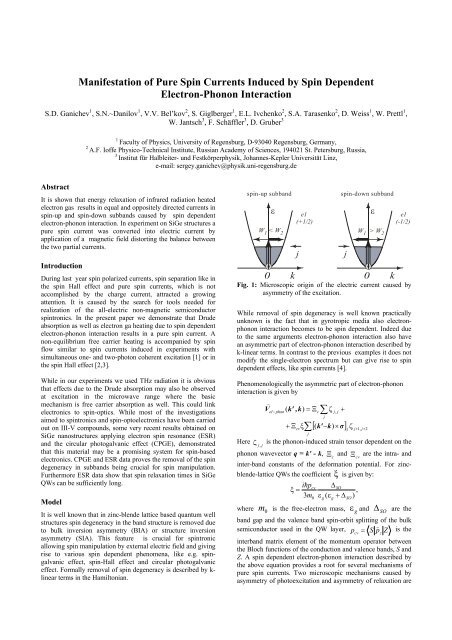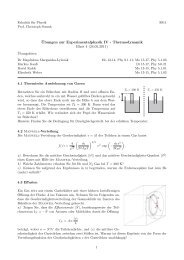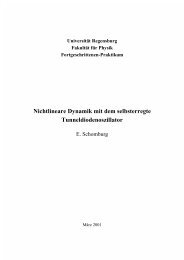Manifestation of Pure Spin Currents Induced by Spin ... - Physik
Manifestation of Pure Spin Currents Induced by Spin ... - Physik
Manifestation of Pure Spin Currents Induced by Spin ... - Physik
Create successful ePaper yourself
Turn your PDF publications into a flip-book with our unique Google optimized e-Paper software.
<strong>Manifestation</strong> <strong>of</strong> <strong>Pure</strong> <strong>Spin</strong> <strong>Currents</strong> <strong>Induced</strong> <strong>by</strong> <strong>Spin</strong> DependentElectron-Phonon InteractionS.D. Ganichev 1 , S.N.~Danilov 1 , V.V. Bel’kov 2 , S. Giglberger 1 , E.L. Ivchenko 2 , S.A. Tarasenko 2 , D. Weiss 1 , W. Prettl 1 ,W. Jantsch 3 , F. Schäffler 3 , D. Gruber 31Faculty <strong>of</strong> Physics, University <strong>of</strong> Regensburg, D-93040 Regensburg, Germany,2A.F. I<strong>of</strong>fe Physico-Technical Institute, Russian Academy <strong>of</strong> Sciences, 194021 St. Petersburg, Russia,3Institut für Halbleiter- und Festkörperphysik, Johannes-Kepler Universität Linz,e-mail: sergey.ganichev@physik.uni-regensburg.deAbstractIt is shown that energy relaxation <strong>of</strong> infrared radiation heatedelectron gas results in equal and oppositely directed currents inspin-up and spin-down subbands caused <strong>by</strong> spin dependentelectron-phonon interaction. In experiment on SiGe structures apure spin current was converted into electric current <strong>by</strong>application <strong>of</strong> a magnetic field distorting the balance betweenthe two partial currents.IntroductionDuring last year spin polarized currents, spin separation like inthe spin Hall effect and pure spin currents, which is notaccomplished <strong>by</strong> the charge current, attracted a growingattention. It is caused <strong>by</strong> the search for tools needed forrealization <strong>of</strong> the all-electric non-magnetic semiconductorspintronics. In the present paper we demonstrate that Drudeabsorption as well as electron ga heating due to spin dependentelectron-phonon interaction results in a pure spin current. Anon-equilibrium free carrier heating is accompanied <strong>by</strong> spinflow similar to spin currents induced in experiments withsimultaneous one- and two-photon coherent excitation [1] or inthe spin Hall effect [2,3].While in our experiments we used THz radiation it is obviousthat effects due to the Drude absorption may also be observedat excitation in the microwave range where the basicmechanism is free carrier absorption as well. This could linkelectronics to spin-optics. While most <strong>of</strong> the investigationsaimed to spintronics and spin-optoelectronics have been carriedout on III-V compounds, some very recent results obtained onSiGe nanostructures applying electron spin resonance (ESR)and the circular photogalvanic effect (CPGE), demonstratedthat this material may be a promising system for spin-basedelectronics. CPGE and ESR data proves the removal <strong>of</strong> the spindegeneracy in subbands being crucial for spin manipulation.Furthermore ESR data show that spin relaxation times in SiGeQWs can be sufficiently long.ModelIt is well known that in zinc-blende lattice based quantum wellstructures spin degeneracy in the band structure is removed dueto bulk inversion asymmetry (BIA) or structure inversionasymmetry (SIA). This feature is crucial for spintronicallowing spin manipulation <strong>by</strong> external electric field and givingrise to various spin dependent phenomena, like e.g. spingalvaniceffect, spin-Hall effect and circular photogalvaniceffect. Formally removal <strong>of</strong> spin degeneracy is described <strong>by</strong> k-linear terms in the Hamiltonian.spin-up subband0εW < W 1 2ke1(+1/2)jspin-down subbandj0εW > W 1 2ke1(-1/2)Fig. 1: Microscopic origin <strong>of</strong> the electric current caused <strong>by</strong>asymmetry <strong>of</strong> the excitation.While removal <strong>of</strong> spin degeneracy is well known practicallyunknown is the fact that in gyrotropic media also electronphononinteraction becomes to be spin dependent. Indeed dueto the same arguments electron-phonon interaction also havean asymmetric part <strong>of</strong> electron-phonon interaction described <strong>by</strong>k-linear terms. In contrast to the previous examples it does notmodify the single-electron spectrum but can give rise to spindependent effects, like spin currents [4].Phenomenologically the asymmetric part <strong>of</strong> electron-phononinteraction is given <strong>by</strong>( k' , k) = Ξc∑ ζj j+V ) el − phon,j+ Ξcvξ∑ [( k' −k)× σ]jζj+1, j+2jHere ζ is the phonon-induced strain tensor dependent on thej, jphonon wavevector q = k' - k, Ξ andcΞ are the intra- andcvinter-band constants <strong>of</strong> the deformation potential. For zincblende-latticeQWs the coefficient ξ is given <strong>by</strong>:ihpcv∆SOξ =,3m0ε g( ε g+ ∆ SO)where m0is the free-electron mass, ε g and ∆SOare theband gap and the valence band spin-orbit splitting <strong>of</strong> the bulksemiconductor used in the QW layer,)pcv= S pzZ is theinterband matrix element <strong>of</strong> the momentum operator betweenthe Bloch functions <strong>of</strong> the conduction and valence bands, S andZ. A spin dependent electron-phonon interaction described <strong>by</strong>the above equation provides a root for several mechanisms <strong>of</strong>pure spin currents. Two microscopic mechanisms caused <strong>by</strong>asymmetry <strong>of</strong> photoexcitation and asymmetry <strong>of</strong> relaxation are
esponsible for pure spin current. Below the first mentionedmechanism being relevant to our experiments is sketched.Microscopic origin <strong>of</strong> the electric current caused <strong>by</strong>an asymmetry <strong>of</strong> the photoexcitation.One <strong>of</strong> the mechanism <strong>of</strong> pure spin-current generation in QWsis related to the asymmetry <strong>of</strong> optical excitation and requiresDrude absorption <strong>of</strong> radiation. Indirect optical transitionsrequire a momentum transfer from phonons to electrons. A spincurrent induced <strong>by</strong> these transitions appears due to anasymmetry <strong>of</strong> either electron-phonon or electron-photoninteraction in the k-space. The asymmetry <strong>of</strong> electron-phononinteraction results in non-equal rates <strong>of</strong> indirect opticaltransitions for opposite wavevectors in each spin subband withs α = 1/2. This causes an asymmetric distribution <strong>of</strong>photoexcited carriers within the subband s α and yieldstherefore a flow, j α , <strong>of</strong> electrons in this subband. This situationis sketched in Fig. 1 for the spin-up (s = 1/2) subband (leftplate) and spin down (right plate). The single and doublehorizontal arrows in Fig. 1 indicate the difference in electronphononinteraction strength for positive and negativewavevectors. <strong>Currents</strong> in spin up and spin down subbands haveopposite direction and therefore cancel each other because theelectron-phonon asymmetry is spin-dependent and changes itssign from one band to another. The characteristic feature <strong>of</strong> thismechanism caused <strong>by</strong> optical excitation is a sensitivity to thepolarization <strong>of</strong> light.Experimental technique and samplesThe measurements were carried out on SiGe QW structuresMBE-grown on (001)- oriented Si-substrates. A single QW <strong>of</strong>15 nm width was doped with Sb from one side only. Forterahertz excitation we used a high power far-infrared pulsedNH 3 laser optically pumped <strong>by</strong> a TEA-CO 2 laser which yieldsstrong linearly polarized emission at wavelengths between 35and 280 µm. In addition mid-infrared radiation <strong>of</strong> CO 2 -laserwas applied. The radiation induces indirect optical transitionsin the lowest conduction subband <strong>of</strong> our n-type samples.The generation <strong>of</strong> pure spin currents was demonstratingconverting <strong>of</strong> them into electric current. This is obtained <strong>by</strong>destruction <strong>of</strong> the balance between spin up and spin downcurrents <strong>by</strong> application <strong>of</strong> an external magnetic field. Indeed,the strength <strong>of</strong> both spin-up and spin-down current isproportional to the number <strong>of</strong> free carriers, thereforeredistribution <strong>of</strong> initially equal population in both subbandsresults due to the Zeeman effect, in different equilibriumpopulations <strong>of</strong> the subbands. Described above spin currentsflowing in opposite directions become non-equivalent resultingin a spin polarized net electric current.Samples were studied in the range from liquid helium to roomtemperature. According to phenomenological theory spincurrents excited <strong>by</strong> linearly polarized radiation and caused <strong>by</strong>asymmetry <strong>of</strong> photoexcitation dependence on the angle αbetween polarization plane and magnetic field direction. Inorder to vary this angle we placed a metal mesh polarizerbehind a crystalline quartz λ/4-plate.magnetic field in-plane <strong>of</strong> the QW. Figure 2 shows thedependence <strong>of</strong> the photocurrent on the angle α for twodirections <strong>of</strong> the magnetic field. The current j y' is proportionalto I ⋅ B y'sin 2αas expected from phenomenological theory.As a function <strong>of</strong> magnetic field current increases with risingfiled strength due to the change <strong>of</strong> subband population caused<strong>by</strong> Zeeman effect.j / P (a. u.)6420-2-4Fig. 2:0n-type (001)-SiG eλ=148 µm, T=300K,j ⊥ B3060Be zj x' [110]90 120α, gradS1 - S2 cos 2αB=+1TB= -1T150180Photocurrent as a function <strong>of</strong> the azimuth angle α. S1and S2 are fitting parameters.We show that spin dependent electron phonon interactionresults in gyrotropic low dimensional structures in a pure spincurrent. The effect was demonstrated in (001)-grown SiGeQWs excited <strong>by</strong> THz radiation. Results <strong>of</strong> this workdemonstrate that spin dependent electron-phonon interactioncan be essential and provide a new tool for spin manipulationbased on spin dependent electron phonon interaction.We thank L.E. Golub for helpful discussion. Financial support<strong>by</strong> the DFG, and the RFFI is gratefully acknowledged.References[1] M.J. Stevens et al., 'Quantum Interference Control <strong>of</strong>Ballistic <strong>Pure</strong> <strong>Spin</strong> <strong>Currents</strong> in Semiconductors' Phys. Rev.Lett. vol. 90, 2003, 136603.[2] J. Wunderlich et al., ‘Experimental Observation <strong>of</strong> the<strong>Spin</strong>-Hall Effect in a Two-Dimensional <strong>Spin</strong>-OrbitCoupled Semiconductor System’, Phys. Rev. Lett. Vol. 94,2005, 047204.[3] Y. Kato et al., ‘Observation <strong>of</strong> the <strong>Spin</strong> Hall Effect inSemiconductors’, Science, vol. 306, 2004, 1910.[4] V.V. Bel'kov, et al., Magneto-Gyrotropic PhotogalvanicEffect in Semiconductor Quantum Well, J. Phys.: Condens.Matter, vol. 17, 2005, 3405.Experimental results and discussionIrradiation <strong>of</strong> the samples without an external field as expectedfrom the mechanisms described above as well as from thephenomenological theory does not lead to any signal. Thecurrent response was first obtained at the application <strong>of</strong> a small





